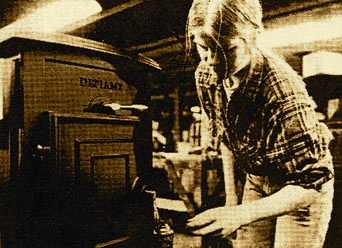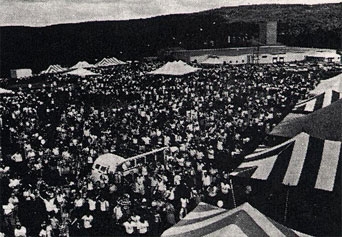Keeper Of The Flame Vol.2
二人はパートナーとして長い渡し板の端と端にわかれ、ハウエルは経営者として、サイムは創造力を武器として互いの才能でうまく経営していった。「私達は世間を圧倒するような経営学修士の概念を持ち合わせているタイプではない。ただ道徳的且つ倫理的なことに強い認識を持っていて、気質やさまざまな決定もそこからきている。いつも最良なものを作るべくベストを尽くしてきた、それは市場価値があったからではなく、自分達がしたいことを表現するのに正しい方法なのではないかと思っていたからだ。」
デファイアントの成功は、クレステッドビュートのあのバーに彼らが座って夢見ていた頃と同じように正義意識を持って進んでいることをよく表している証拠のようだ。「だから私達のしていること、製品の質、お客様へのサービス、その全てでそれを表現していきたい。他のみんなと同じように仕事に出掛けるということがないならば、私達全員にとってこれが並外れた経験になるようにしたい。」
‘稀有で独特’という主義は製品から始まった。‘ずっと使えるものづくり’にサイムはこだわった。それぞれのストーブは2度に渡って組み立てられる。研ぐ、乾性ではめ込む、分解する、もう一度研ぐ、そして暖房炉接着剤で再び組み立てる。そこで作った者自身がサインを入れる。
ハウエルとサイムはただその卓越さを説いていただけではなかった。彼らは電話対応をし、手本となるようにストーブを次々に設置した。「鋳物に触れる全ての人が品質管理調査官というのが基本的な慣行となった。もし品質問題かなと思っていたらそのストーブを横に寄せた。」バーモントキャスティングス社最初の社員、ビル・フロイドは覚えている。「中途半端はない完璧ではないなら製品ではない!」
ストーブに関する全てが期待以上であるから、顧客は驚いていたに違いない。苦情は簡単に解決した。もしうまく作動しないストーブなら新しいものに変える、議論は必要ない。「私達が目指すのは、皆様がずっと続いていく価値のある何かを手に入れて頂くこと。」とサイムは言う。「どこかで失敗したとしても、それは訂正しなければならない欠陥が何かわかるということ。」 ただストーブを買っていたのではなく、バーモントキャスティングスの仲間メンバーを得ていたのだ。

地域では最高の賃金と手当てがあり、利益は分配され、自分達がナンバーワンだと思える満足感があった。職場としても稀有で独特であったのだ。社員は需要に見合うようにニ交代制で熱心に働いたが、パーティーも十分楽しんだ。部門別に生産記録やデザインの不具合の製造問題を解決すれば、ビール6本をプレゼント!会社中でクリスマスパーティーやハロウィーンパーティー、冬の雪が全て溶けてなくなればその日に春のパーティーをした。
計画とかそういうものはいつも気軽に行われた。サイムは言う、「私達は生産工程を良くしていくことを複雑に考えることは決してなかった。デファイアントはものすごく売れていたが、お客さんから150回大きすぎると言われれば、アイディアが浮かぶものだ。」 そこでサイムはビジラントをデザインした、機能は高いままでサイズは小さくドアのところに好みでガラスをつけることもできる。新しいストーブの流れはそのように始まった、それぞれが前のものより高い燃焼効率で、顧客好みの新しい特徴を備えていた。
唯一の問題は部品の供給であった。アメリカの鋳型工場で十分な品質の部品を製造できるところはほとんどなかったのだ。しかしより熟練したヨーロッパの能力に頼ることで、電話からの客の好みに何でも対応しようというバーモントキャスティングス社の柔軟性を狭めてしまった。1979年、サイムとハウエルは彼ら自身の施設を建設した。 19世紀が変わって以来アメリカで建てられるストーブプレートの鋳物の為の最初の鋳型製造所であった。
彼らは、5,000万ドル分の生産能力のある大きな製造所を設計することを夢に描いた。発展、それは明白な天命であると感じた。彼らは次の売上金5,000万ドルを目指して事業の絶対的な力を建設していた。すでに新しい管理者を連れてきて、工程を手伝ってもらっていた。
銀行家は懐疑的だった。しかし銀行家がどう考えようと問題ではなかった。ストーブは550万ドルの建設費用のうち25万ドル以外すべて現金で支払えるほど急速に売れていた。
1979年6月建設が完成すると、近隣の人々に会社を宣伝するチャンスであろうと施設一般公開を決めた。多くの人が来ることを期待していたわけではなかったので、‘オーナーズニュース’で小さく触れただけだった。
するとあらゆる地域から5,000人のデファイアントのお得意様が訪れた。そこから伝統は生まれ、年一回オーナー達のピクニック、だんだん増えていく人数で毎年8月に理想を祝った。

振り返ってみると1980年のオーナー達のピクニックがおそらくバーモントキャスティング社の歴史の中で最も盛り上がったかもしれない。売上はもう一年ほどで2,900万ドルにも達するというところだったが、1980年のクリスマスの頃ハウエルはガンと診断された。その次の年、ハウエルは亡くなった。

マネー誌によれば、バーモントキャスティングス社の薪ストーブは ‘アメリカ人が作った最高のもの99’にはいっていたが、環境保護局(EPA)は新しい国家排出基準を宣言した。それは法人基準の代表のような存在のデファイアントを市場から完全に去らせることになった。
1986年7月に紹介されたデファイアント・アンコールは、どんな連合や州の規則より排出(排気物量)が低く、どの競合製品に比べてもかなり低くおさえるように出来ている最新技術の型だった。
企業哲学、資産そしてさまざまな機会でのバーモントキャスティングス社の‘理想像についての意見’は、会社を通して行き渡った。 ‘標準と期待以上の意義’として稀有で独特という基本的な信条に再反抗し、そして企業と全社員のゴールは‘全方面で並外れた人生経験’ を顧客、地域、自身にももたらすことだと約束して始めた。
ストーブは突然のインスピレーションによってサイム、R&Dのファーガソン、マーケティングのアブレイン、デザインのバンス・スミス、設計技術のジグス・ブラックバーンとアル・ウィルカーのグループで始まった。彼らは現場の外で会うだけで電話からも離れていて、まるで依頼人であるバーモントキャスティングス社に出向く下請け業者のように仕事をしていた。彼らの権限は規則にとらわれていなかった、製品を作るのに行き詰まらないようにコンセプトを練り上げ、目的を割り当てた。そうしてストーブは設計の過程にすぐ移されていった。その先様々な部署から意見を取得し、ストーブは原型の鋳型から組立手順の型押しを設計するようになったので、組み立て職人や営業スタッフなどを含めてデザインが完成されました。
技術設計の革新の探求は本当に稀有で独特なことである。制度化された作業の卓越さを作り出すことはどんなリーダーにとっても賛辞である。
イントレピッド、レゾリュート、などを次々開発した。彼らは石炭用にビジラントも最新にした。それらも改善し現在各種製品が再設計され新しいデザインになっている。
バーモントキャスティングス社は今もなお伝説である。彼らはこれからも世界でも最高といわれるストーブを設計し続ける。
翻訳:沐日社
Keeper Of The Flame
The two partners managed by instinct, working at opposite ends of a long wooden trestle with Howell as the businessman and Syme as the creative force. “We weren’t two guys with an M.B.A.’s notion of how to kill the world. We had a strong sense of ethics and morals, and out of those came habits and decisions. We did our best to make the best — not because it had marketing value, but because it seemed the right way to express what we wanted to do.”
The success of the Defiant seemed eloquent proof that they’d been right-on when they’d sat dreaming in the bar in Crested Butte, they agreed. “So let’s put that into everything we do — the quality of the literature, the way we serve our customers, everything. And let’s make this an extraordinary experience for all of us — if we aren’t going to have that we might as well go work for someone else.”
The religion of “rare and unusual” started with the product, “built to last forever,” Syme insisted. Each stove was built twice: ground, dry-fitted, taken apart, and reground, then reassembled with furnace cement. Then it was signed, personally, by its builder.
Howell and Syme didn’t just preach excellence; they stood on the line, setting the example stove by stove. “It became standard practice that everybody who touched a casting was a QC inspector — if you didn’t like it you’d put it aside,” Bill Floyd, Vermont Castings’ first employee, remembers. “There was no close enough; it was either there, or it wasn’t.”
Everything about the stove had to surprise their customers, giving them more than they expected. Complaints were dealt with simply: if your stove didn’t work you’d get a new one, no questions asked. “Our intention was for you to have acquired something of lasting value,” Syme says. “If it failed in any way there was an implied breach that had to be rectified.” You weren’t buying a stove, you were buying membership in a movement,
It was a rare and unusual place to work, too: the best wages and benefits in the region, profit sharing, and the satisfaction of knowing you were number one. They worked hard, double shifts to meet demand, but they partied hard, too, departmental six-packs for a production record broken or a design problem solved, company wide Christmas parties and Halloween parties, and a spring fling on the day the winter’s snow finally disappeared.
Planning, such as it was, was casual. “We never considered anything as sophisticated as developing ‘a line,’ ” Syme says. “The Defiant was selling like crazy, but after you hear 150 times from customers that it’s too big, you get the idea.” So Syme designed the Vigilant, a smaller stove with still higher efficiency, adding optional glass on the doors. Thus began a steady stream of new stoves, each more combustion efficient than the last, each with new customer-oriented features.
The only problem was the supply of parts. Few of America’s rusting foundries produced parts of high enough quality. But depending on the more sophisticated European facilities limited Vermont Castings’ flexibility to build whatever those people on the phone wanted. In 1979 Syme and Howell built a facility of their own, the first new foundry for the casting of stove plate to be built in the United States since the turn of the century.
They dreamed big, designing the foundry with capacity for $50 million in stoves. Growth, they felt, was “manifest destiny”; they were building the industry juggernaut, with $50 million in sales the next plateau. They’d already started bringing in new managers, outside professionals to help them take that step.
The bankers were skeptical. But it didn’t matter what the bankers thought. Stoves were selling so fast that Syme and Howell paid all but $250,000 of the $5.5-million construction cost out of cash flow.
In June 1979, construction completed, they decided to throw an open house, a chance to show off the company to their local neighbors. They weren’t expecting much of a crowd; there’d been no effort to spread the world, except for a short note in the “Owners’ News.”
Five thousand people showed up, proud Defiant owners from across the country. So a tradition was born, the annual Owners’ Outing, a gathering of the tribe, repeated every August in growing numbers, a celebration of the dream.
Looking back, the 1980 Owners’ Outing was probably the high point in Vermont Castings’ history. Sales would climb for one more year, to $29 million, but by Christmas 1980 Howell’s cancer had been diagnosed. Howell died the next year.
Vermont Castings’ wood stoves were still among the “99 Things that, Yes, Americans Make Best,” according to Money magazine, the Environmental Protection Agency was set to announce tough new national emission standards that would force the Defiant, the corporate standard bearer, off the market completely.
the Defiant Encore, introduced in July 1986, the new state-of-the-art model, with emissions lower than any federal or state regulations, and far lower than any competitors’.
Vermont Castings “Vision Statement,” a 21-page meditation on corporate philosophy, assets, and opportunities circulated throughout the company. He started by redefining the basic creed of rare and unusual as “significantly above the average and expected,” promising that the goal of the company and all employees would be to provide “an extraordinary life experience in all ways” to customers, community, and self.
A stove started in the advanced development group, brainstormers including Syme, Ferguson from R&D, Abrain from marketing, Vance Smyth from design, Jiggs Blackburn and Al Wilker from design engineering,. They met off site, away from ringing telephones, working as if they were a subcontractor reporting to Vermont Castings as a client. Their mandate was freeform: formulate a concept and assign objectives, without bogging down in how to make the product. Then the stove was handed off quickly to process design. There the system was opened up, and slowed down to allow designers, builders, and marketers to have their full say as the stove moved from master patterns to design tooling to assembly procedure.
Pursuing the grail of technological and design innovation is, truly, a rare and unusual thing. And creating institutionalized operational excellence is a tribute to any leader.
Then they did the Acclaim, then retrofitted the Intrepid and then the Winterwarms. They also updated the Vigilant for coal. Now they have a full line of redesigned and newly designed units.
VC is still a legend. They continue to design some of the best stoves in the world.
I am regular reader, how are you everybody? This post posted at this site is
actually fastidious.